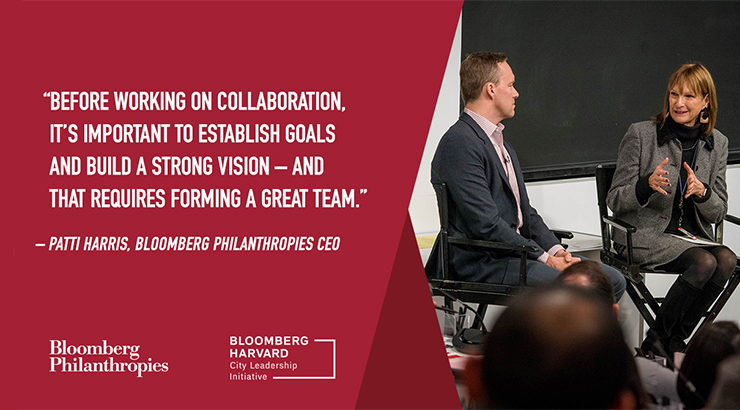3 Ways to Promote a Culture and Practice of Collaboration

By Patricia E. Harris, CEO of Bloomberg Philanthropies
Mayors often come into office with bold ideas for tackling the toughest issues – whether it’s gun violence, school readiness, homelessness, or workforce development. And if they don’t know it before they get to city hall, one of the first things they learn upon arrival is that they can’t go it alone.
The truth is that the most successful and sustainable solutions demand the buy-in, brainpower, and resources of stakeholders across a city, including universities, nonprofits, businesses, foundations, and neighborhood groups.
Collaboration across these sectors was key to all that Mike Bloomberg accomplished in his 12 years as mayor of New York City. It has also been key to our work at Bloomberg Philanthropies, where we’ve sought partnerships with other foundations and helped city leaders in hundreds of cities tackle major challenges – often by tapping wisdom, creativity, and resources from citizens, community groups, and businesses.
This week, one of our most exciting collaborations, the Bloomberg Harvard City Leadership Initiative, was back in session. Launched last summer in partnership with the Harvard Kennedy School and the Harvard Business School, it’s a first-of-its-kind executive education program for 40 mayors from around the world, as well as their top staff. And the topic of the four-day session that took place this week was – guess what? – collaboration.
The idea to focus on cross-sector collaboration came from the mayors themselves, who told us that forging these partnerships is one of the most important – and difficult – parts of their jobs. So we brought 80 people from 10 cities to New York City to help them learn how to do it better. These city teams included top city hall staff and, importantly, local leaders from the business, nonprofit, education, and philanthropic sectors. They spent the week learning from experts about setting shared goals, having difficult conversations, and many other collaboration “do’s” and “don’ts.” The city teams alternated between time in the classroom and small-group workshops, where facilitators helped them apply these lessons to the real-life, real-time challenges they’re facing back home.
Among the many lessons I hope attendees take away from this week’s session are three things that have always helped me to promote a culture and practice of collaboration.
- Set the expectation to collaborate from the top. There is no replacement for a CEO, nonprofit executive director, or city leader making it clear that partnerships are important and expected. The reality is collaborations take time and energy and rarely represent the shortest path from A to B. That means bosses need to drive home that they value “going it together” more than they do “going it alone.”
- Lead with “Yes.” When you’re presented with a partnership opportunity, the easiest answer is usually no. But collaboration requires flexible thinking when there are clear gains to be made. Leading with “yes” is not the same as being a “yes person.” It’s about being open to good ideas and willing to jump on them. In the months after the 9/11 attacks on the World Trade Center, for example, it would have been easier to say no to artists Christo and Jeanne-Claude’s idea to stage The Gates, a massive public art project in Central Park. We had our hands full. But we led with “yes,” and with the help of nearly every city agency, executed a collaboration that showed the world that New York was back on its feet.
- Hardwire collaboration. Successful collaborations don’t just happen. They require intention – and usually an organizational structure. That can be as simple as holding regular meetings to keep partnerships on track. It can mean having employees swap jobs for a few weeks, as we do at Bloomberg Philanthropies, to encourage learning about how other parts of the organization work.
None of this is easy. But, as the 40 mayors and teams participating in this year’s Harvard Bloomberg City Leadership Initiative prove, collaboration is something that city staffs of all shapes and sizes can get even better at. And, most importantly, it’s something that will have incredible impact with the right intention, attention, and hard work.